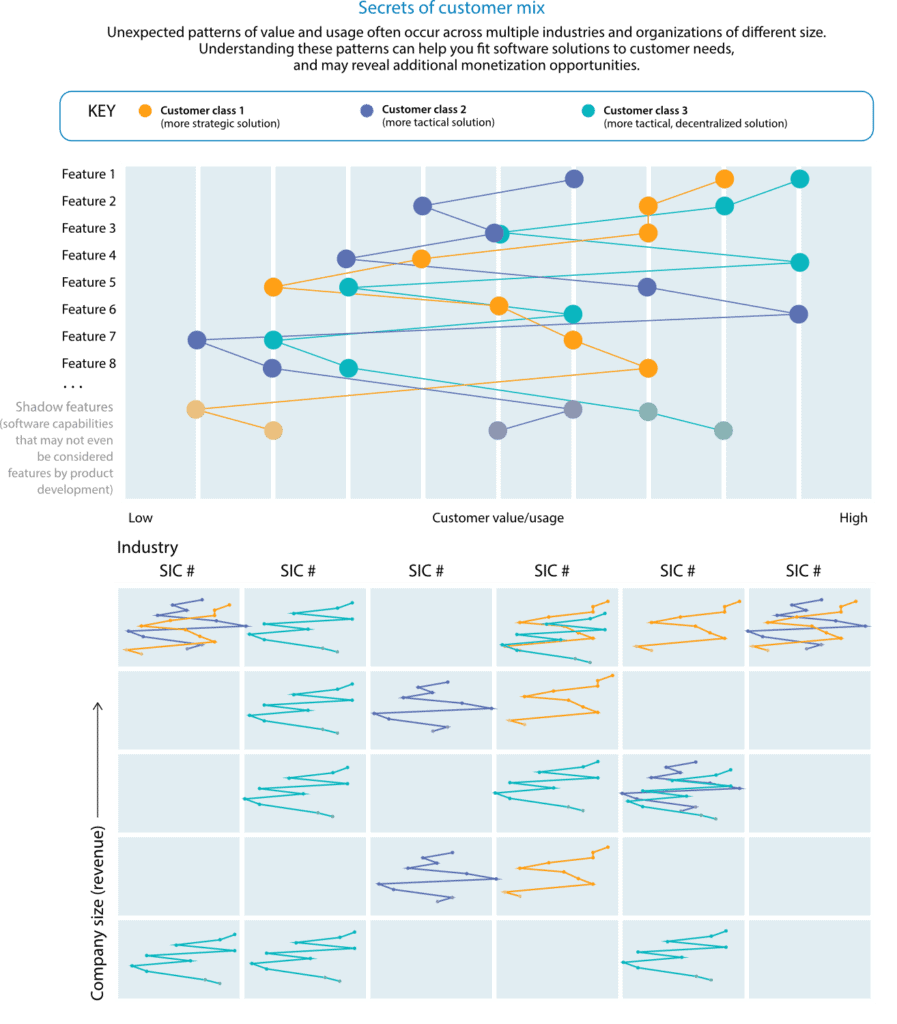Which type of B2B software pricing strategy is more customer-centric, fair to buyers, and profitable for sellers?
Value-based pricing and needs-based pricing are similar, in that they’re both grounded in attempts to understand customers. That’s a more customer-centric approach than basing software pricing on, say, what competitors are charging.
In this blog, I’ll explain and contrast these two approaches to B2B software pricing. But first, let me say that in practice both a value-based pricing strategy and needs-based pricing strategy often veer away from customer centricity. Because of problems in pricing strategy creation and execution, these pricing methods can end up being unfair to software buyers and produce less profitable results than they should for software sellers.
There is a way to merge these pricing strategies, and keep strategy and execution fixed on customers, never sliding off that center. It’s a practical approach for implementing the ideal pricing method into operational reality—it’s how you walk the talk of customer centricity. I’ll cover that too.
What is value-based software pricing?
Value-based pricing is based on the customers’ perceived value that your software will contribute to their business. A strength of this approach is that it forces you to research how customers perceive your product, rather than being overly rooted in how your organization sees things. It’s an especially good approach for SaaS, where to some extent retaining subscribers requires delivering a stream of added value over time.
A limitation of a value-based pricing strategy is that efforts to understand customers may never go beyond perceptions, which are subjective and can shift in response to external factors such as new competitive products entering the market. A more insightful, reliable approach looks also at how customers use software to derive value (and create value for their customers as the next link in the value chain). When you understand this, you’ll see opportunities to influence customer perception of value, build it over time and hold it steady amidst competitors’ actions and market change.
Another problem with a value-based pricing strategy is that it can degenerate into an almost sole focus on willingness to pay. Figuring out what the price points are, companies may put too much credence in unreliable inputs, such as what customers say they’re willing to pay (usually lower than what they actually will pay), as well as unproven data algorithms. Many studies have found such techniques to be inaccurate and misleading. That was our experience at Software Pricing Partners as well, so we no longer use them.
Often, willingness to pay will be estimated at the industry level. So, for example, a software provider may end up charging a higher price for an oil and gas customer, the rationale being that they can afford more than a manufacturer, even though both customers are buying the same set of products and services at the same volume, and will use the software in the same way. A more equitable approach bases pricing on these very commonalities, which frequently cross industry lines.
In fact, if you’re using industry designations like SIC codes to create your pricing model (and other aspects of your monetization strategy like licensing and packaging), you’re likely missing a lot. I call this “operating at an aggregate” because it glosses over important nuances of how customers within an industry differ—and how customers from different industries are similar. These nuances reveal opportunities to better understand your customer mix and differentiate your products in the marketplace.

What is needs-based software pricing?
Needs-based pricing is part of an approach to software development and marketing that seeks to be as customer-driven as possible. Developed as a corrective to traditional features-centric, internally driven methods, it revolves around the question, “What do our customers need to be successful with our software?”
Generally, there’s no single answer, so companies create market segments of customers with similar characteristics and needs. A strength of this approach is that product roadmaps and GTM strategies tend to track customer experience, feedback and changing conditions.
A limitation of the needs-based approach is that companies often create their segments based on the traditional marketing stack. Broad-brush criteria, such as industry, revenue size and number of employees, are combined with the ever-popular definitions of buying personas and ideal customer profiles.
These aren’t effective ways of analyzing the far more complex realities of customer behavior, usage and value extraction at the core of successful software monetization. For example, “Betty in Purchasing” in a decentralized purchasing environment differs quite a bit from “Betty in Purchasing” in a centralized purchasing environment. “Doug, the event coordinator” might have largely the same needs as “Sam, the heavy equipment renter,” even though they are in very different industry verticals. Traditional segmentation, therefore, may not be an accurate representation of the real customer mix. The result can be over-simplified or over-complicated packaging that adds friction to the sales process.
Another problem with this approach is that it often degenerates into one-off deals. Sales teams are encouraged to tailor solutions to customer needs—but poor packaging strategies leave them with few ways to do it. They fall back on discretionary pricing of bespoke deals or custom packages. The result is prolonged sales cycles and reduced profits.
Worse, B2B customers even within the same industry may end up paying unjustifiably different prices for the same set of products and services at the same volume. Word gets around, eroding the seller’s reputation and buyers’ trust. Mistrustful customers slow or derail future deals by resorting to risk-mitigating measures or trying to game what they perceive as an unfair system.
A better approach closely fits solutions to customer needs while pricing in a way that’s equitable for all buyers—and more profitable for sellers.
Combining their strengths, going beyond their limitations
Market Fairness Pricing is a systematic, data-driven approach to software monetization, covering licensing, packaging and pricing model (with a structured discounting framework). This approach:
- Goes beyond perception of customer value to thoroughly analyze how customers use and derive value from software
- Provides frameworks for segmenting customers based not only on similar needs but on how they organize their world, thereby picking up significant similarities and differences that cross traditional marketing delineations
- Reveals the real customer mix, including visibility into mix changes over time and easier identification of additional monetization opportunities
- Reduces sales cycles/cost, margin swings and revenue leakage while building buyer trust and relationship profitability
- Is truly customer-centric, helping sales teams fit software solutions to each customer within a monetization framework that is fully transparent and fair to all buyers
- Creates asset transfer value by building a powerful playbook on how customers/prospects react to pricing and packaging changes. Meanwhile, the sales team is amassing an impressive track record of consistently landed net prices—demonstrating that the organization can command its value. This organizational knowledge, which can be passed down to the company’s next owner, increases company valuations.
Learn more about this pricing strategy
By merging the best aspects of a value-based strategy and needs-based strategy, you can improve customer loyalty, provide more value and boost revenue. You’ll find more specifics in my previous post Get out of Dodge!—time for software pricing to join the modern world. Or feel free to contact me at chrismele@softwarepricing.com.
